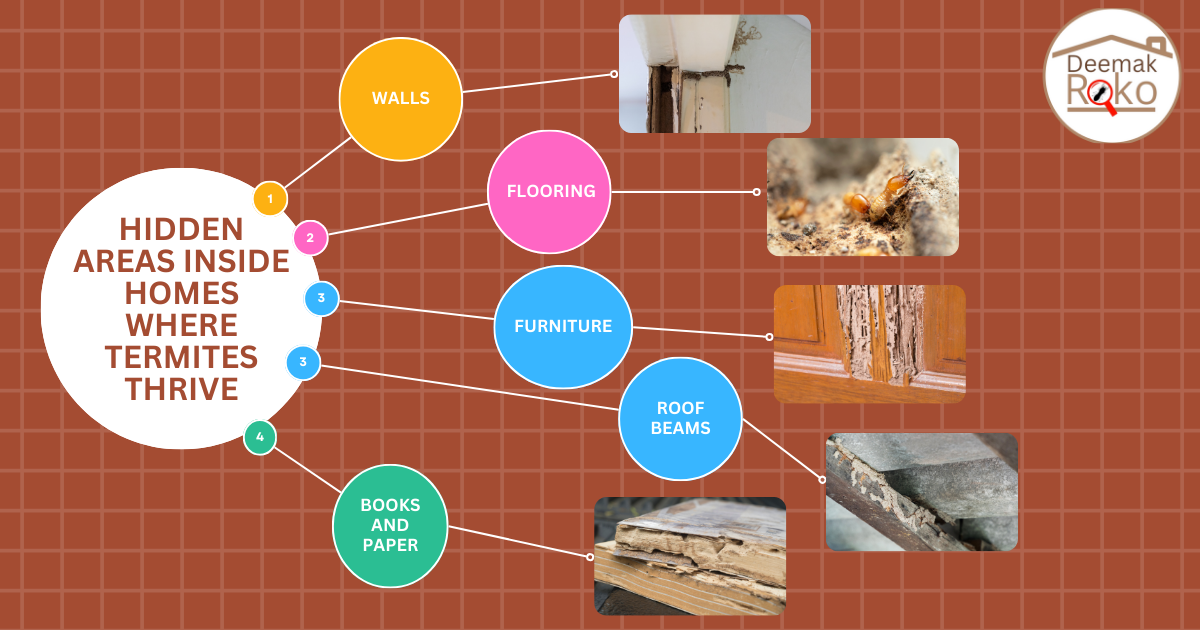Termites, known as silent destroyers, can cause extensive damage to homes if left unchecked. In fact, these pests are experts at hiding in termite hidden areas, where they’re least expected, causing severe damage before detection. As a result, identifying and safeguarding these termite hidden areas is crucial for protecting your home’s structure. Furthermore, in this blog, we’ll explore common termite-prone areas and provide effective strategies for safeguarding them—so you can keep your home termite-free.
Why Termites Thrive in Hidden Areas
Termites prefer undisturbed, hidden areas where they can build colonies unnoticed. In addition, they’re drawn to damp, dark spaces with easy access to wood. As a result, because these areas remain unseen, termites can cause significant structural damage over time. Therefore, understanding why termites thrive in these spots can help homeowners address potential risks before serious issues arise.
Top Termites Hidden Areas Inside Homes
1. Inside Walls and Wall Voids
- Why it’s a Problem: Walls, particularly insulated ones, provide both food (wood) and cover.
- Signs to Watch For: Listen for faint clicking sounds inside walls, look for paint bubbling or buckling, and watch for tiny mud tubes.
2. Under Flooring and Subfloors
- Why it’s a Problem: Subfloors provide the perfect environment for termites, with ample moisture and food sources.
- Detection Tips: Check for signs of sagging floors, hollow-sounding wood, and mud tubes under floorboards.
3. Furniture and Stored Wood Items
- Why it’s a Problem: Stored wood, cardboard boxes, and wooden furniture can attract termites, especially in garages or sheds.
- Tips for Checking: Regularly inspect stored items for visible frass, hollow wood sounds, or other damage.
4. Attics and Roof Beams
- Why it’s a Problem: Wood framing in attics, beams, and support structures are prime targets.
- Inspection Tips: Inspect for weakened wood, termite droppings (frass), or discarded wings. Look for blistered wood or soft spots.
5. Books and Paper
- Why it’s a Problem: Termites are highly attracted to cellulose, which is found in paper and books. Shelves, storerooms, or basements with stacked books or paperwork provide an ideal food source.
- Tips for Detection: Look for small piles of frass (termite droppings) around book edges or shelves, tiny holes in pages, or signs of crumbling paper.
- Prevention Advice: Regularly check stored books and paperwork, keep them off the floor, and store them in dry, well-ventilated areas to avoid attracting termites.
Warning Signs of Termites in Hidden Spots
If you notice any of these signs of termites infestation, it could mean you have a termite problem. Here’s what to watch out for:
- Mud Tubes: Termites build these pencil-sized tunnels to protect themselves. Look along walls, floors, and foundations.
- Wood Damage: Termite-damaged wood sounds hollow when tapped and may be blistered or warped.
- Frass (Droppings): Look for small, dry pellet-like droppings in hidden areas like corners and along walls.
- Swarmers or Wings: Spotting flying termites or finding discarded wings near windows or in basements could indicate an active infestation.
Tips to Protect Hidden Areas from Termite Infestation
Prevent termites from taking over your home by following these tips:
1. Schedule Regular Professional Inspections
- Professional inspections are key to detecting termites early. In fact, DeemakRoko recommends annual termite inspections for all homes, particularly in high-risk areas. Furthermore, regular inspections help ensure that any potential issues are addressed before they cause significant damage.
2. Control Moisture Levels
- For instance, use dehumidifiers in basements and ensure there are no leaks in plumbing. Additionally, reducing moisture makes your home less attractive to termites, thus lowering the risk of infestation.
3. Seal Cracks and Entry Points
- Seal gaps in walls, around windows, and along the foundation. This blocks termites from entering your home.
4. Use Termite-Resistant Materials
- Consider using treated wood or termite-resistant materials, especially during renovations or new construction. This adds an extra layer of protection to your home.
Book Termite Pest Control from DeemakRoko
Protecting your home from termites doesn’t have to be a hassle. In fact, at DeemakRoko, our termite control services include everything from thorough inspections to eco-friendly treatments tailored to your home’s needs. Additionally, we identify hidden risks and create a comprehensive protection plan to keep termites out for good. As a result, you can enjoy peace of mind knowing your home is safe and secure.
Contact DeemakRoko today to schedule a termite inspection and prevent termites from causing costly damage.
FAQs about Termite Control
Termites thrive in dark, damp, and undisturbed locations, where they can build colonies undetected.
DeemakRoko recommends annual inspections for optimal termite prevention and early detection.
- Early signs include mud tubes, hollow-sounding wood, frass, and finding discarded wings.
DeemakRoko uses eco-friendly termiticides and advanced inspection techniques to protect your home, creating a long-lasting barrier against termites.
Keeping hidden areas protected from termites is essential to safeguard your home’s structure and value. Termites often go undetected until they cause significant damage, so proactive steps like regular inspections and preventive treatments are key.
Take action now—schedule your termite inspection with DeemakRoko and secure a termite-free home for peace of mind.

